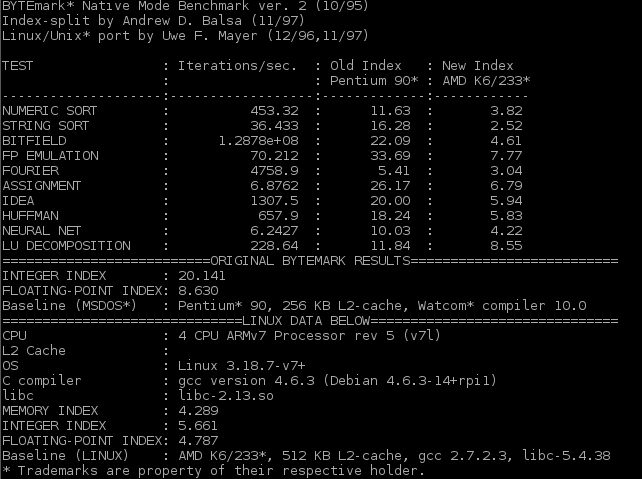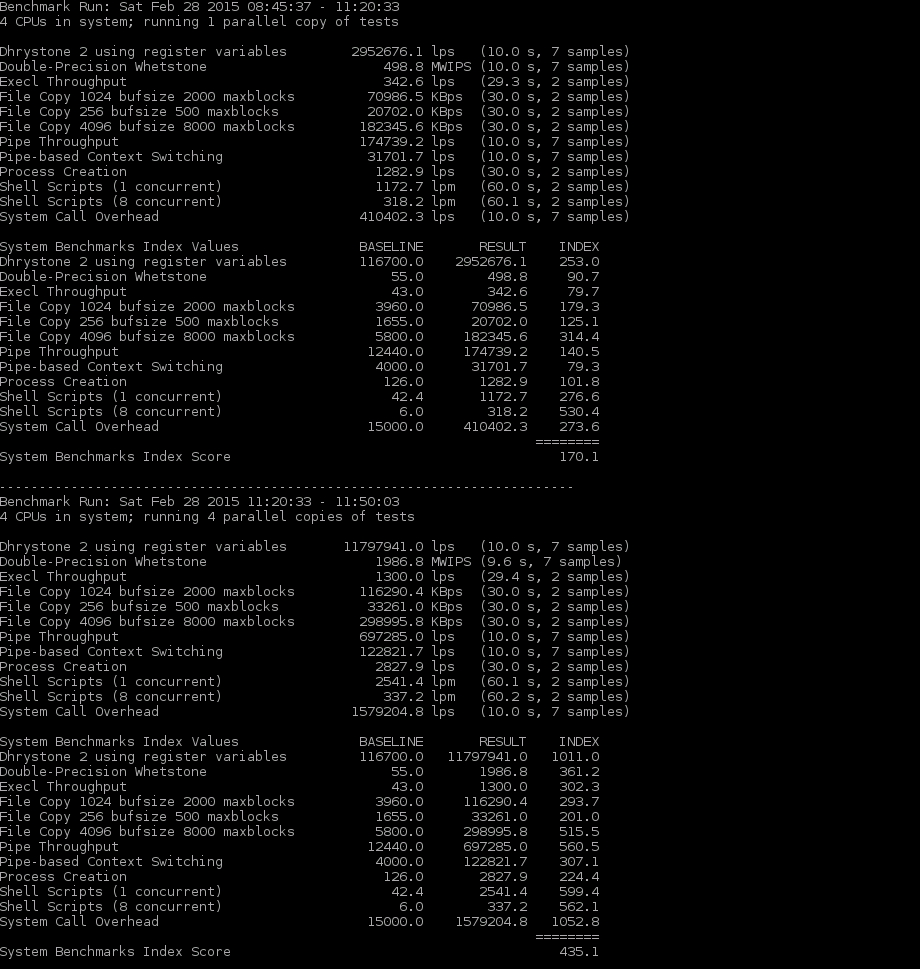Last Updated on December 24, 2022
Performance: Benchmarks
Central to the Raspberry Pi 2 is a Broadcom BCM2836 quad-core ARM Corex-A7 CPU running at 900MHz. Like the original Pi, it is a system on a chip: an integrated circuit that integrates all components of a computer or other electronic system into a single chip. The BCM2736 retains all the features of the BCM2835 used in the original Pi, but the 700MHz ARM11 CPU has been replaced with a quad-core CPU running at a higher clock speed.
The ARMv7 processor means that the Pi 2 can run a complete range of ARM Linux distributions. In fact, there are more than 45 different distributions available, although the majority are not supported by the Raspberry Pi Foundation. Instead, users are steered towards Raspbian (Debian Wheezy), Snappy Ubuntu Core (for developers), OpenElec (an XBMC media centre), Raspbmc (another XMBC media centre), Pidora (a remix of Fedora) and RISC OS (a non-Linux distribution). We are eager to see the Raspberry Pi 2-compatible version of Windows 10 being available, particularly as it will be free of charge to makers.
All of the tests have been performed on an unmodified Raspberry Pi 2 running the latest version of Raspbian. In the same way as the original Pi, performance can be increased by overclocking the CPU, GPU, and the RAM. To ensure the machine stays stable, overclocking should be fairly conserative and the voltage supplied to the Pi 2 should be bumped up a bit. As the Pi 2 has 4 cpu cores, overclocking is more adaptable to various tasks. I have also not changed the gpu_mem allocation. If the Raspberry Pi 2 is being used as a gaming or in a desktop environment, you can increase the split of memory between the CPU and GPU more in favour of the GPU. The converse will be true if the Pi 2 is being used say as a web server, firewall, weather station etc.
SunSpider
SunSpider is a real world JavaScript benchmark that tests the core JavaScript language. The original Raspberry Pi scores 14650.3ms. Running the test on the Raspberry Pi 2 yields a result of 4474.3ms, which is about 3.5 times quicker. For full benchmark results, click this link.
Google Octane
Google Octane is another benchmark for measuring a JavaScript’s engine performance. It runs a suite of tests representative of today’s complex and demanding web applications, with the latest verion measuring garbage collection / compiler latency and asm.js-style JavaScript performance.
The Raspberry Pi 2 delivered a total geometric mean score of 327, while the original Model B crashed repeatedly when attempting to run the test. To put the Pi 2 score into a little perspective, a Samsung S4 mobile phone and a PC running a low powered i3 CPU (i3-4010U CPU (1.70GHz)) score 2627 and 12827 respectively.
NBench
NBench is a single core synthetic computing benchmark which tests both integer performance and floating point performance.
The Raspberry Pi scores 20.141 in the integer index, and 8.630 in the floating-point index. The scores are almost identical to the Banana Pro, and significantly outperform the original Raspberry Pi (11.66 and 3.89 respectively). Full results are available in the screenshot below.

Unix Bench
UnixBench is another popular synthetic indicator of the performance of a Unix-like system. This test handles multi-CPU systems, and gives an overall system benchmark. With the test running 4 parallel copies of tests, the Raspberry Pi 2 attains a system benchmarks index score of 435.1. This is not far from an AMD Sempron 3400+ processor with an index score of 556.2.
When running 1 parallel copy of tests, the Pi 2’s system benchmarks index score is 170.1. The Raspberry Pi 1 scores 110.2.

HardInfo
HardInfo acts both as a system profiler and benchmark. Here are the results of HardInfo’s benchmarks.
| Raspberry Pi 2 | Raspberry Pi | Intel Core i5-2500K | Celeron 1.50GHz | Power PC 740/750 (280 MHz) |
|
| CPU Blowfish | 61.76 | 100.83 | 2.53 | 26.19 | 172.82 |
| CPU Cryptohash | 15.47 | 8.79 | 639.99 | – | – |
| CPU Fibonacci | 16.14 | 26.48 | 1.49 | 8.14 | 58.08 |
| CPU N-Queens | 51.42 | 86.26 | 4.23 | – | – |
| FPU FFT | 79.87 | 150.97 | 0.84 | – | – |
| FPU Raytracing | 74.69 | 133.85 | 3.34 | 40.88 | 161.31 |
For all of the tests above with the exception of CPU Cryptohash, lower figures are better. Bear in mind that these tests only use a single core. This explains why the tests are not 6x faster. Still, even with a single core comparison, the Pi 2 is significantly quicker in all tests compared to the original Pi.
GtkPerf
| Raspberry Pi 2 |
Raspberry Pi |
Intel Core i5-2500K | |
| GtkEntry | 0.19 | 0.84 | 0.01 |
| GtkComboBox | 3.64 | 17.09 | 0.44 |
| GtkComboBoxEntry | 2.63 | 11.38 | 0.20 |
| GtkSpinButton | 0.55 | 2.64 | 0.04 |
| GtkProgressBar | 0.42 | 2.05 | 0.04 |
| GtkToggleButton | 0.60 | 2.97 | 0.36 |
| GtkCheckButton | 0.37 | 1.97 | 0.04 |
| GtkRadioButton | 0.51 | 2.67 | 0.08 |
| GtkTextView – Add text | 1.70 | 10.40 | 0.40 |
| GtkView – Scroll | 0.61 | 3.94 | 0.08 |
| GtkDrawingArea – Lines | 1.73 | 28.62 | 0.43 |
| GtkDrawingArea – Circles | 3.55 | 36.47 | 0.53 |
| GtkDrawingArea – Text | 2.90 | 20.34 | 0.41 |
| GtkDrawingArea – Pixbufs | 0.60 | 1.95 | 0.08 |
| Total time | 20.27 | 143.44 | 3.17 |
As you can see, the test runs an impressive 7x quicker on the Pi 2 compared with the original Pi. Whilst GtkPerf only uses a single core, the time of the test is reduced as Xorg consumes one of the other cores.
SysBench
SysBench is a multi-threaded benchmark tool for testing CPU performance, memory allocation, file I/O performance and more. The CPU test using a single core of the Pi 2 executed in 296 seconds; running the test again using all 4 cores reduced that to 74.4 seconds. With the original Raspberry Pi, the test executed in 511 seconds. Again, the CPU test executes more than 6 times faster with the Pi 2.
Next Page: Software
Read ahead
1. Introduction
2. Benchmarks
3. Software
4. Summary